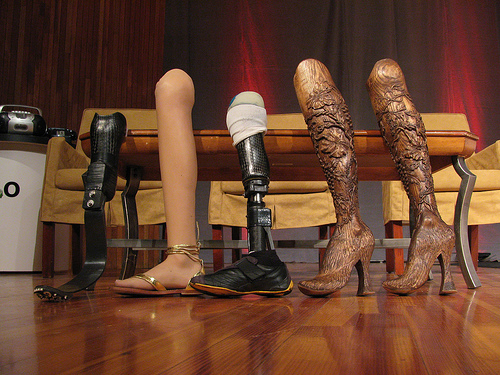The 2012 Guardian newspaper ad really captures the flow of information in the age of ICT (Information Communication Technologies). The ad retells the story of the 3 little pigs, their houses, and the big bad wolf. It shows how stories change with spin and through propagation through social media: twitter, Facebook, email, etc. Well done!
Background Knowledge Errors
Background Knowledge, Background Knowledge Errors, Conceptual Design, Cultural Bias, Cultural Differences, Ethnographic & User Data, Pipsqueak Articles, Product Design Strategy, Users
US Rio+2.0 Breakout Session on Environmental & Conservation Education
by Olga Werby •
Below are the notes from the US Rio+2.0 conference hosted at Stanford last week. The notes are from the Education: Environment and Conservation breakout session. US Rio+2.0 Breakout Session Education: Environment and Conservation Attendees: Prof. Anthony D. Barnosky: Professor and Curator, Department of Integrative Biology at University of California Berkeley Wali Modaqiq: Deputy Director General (DDG), National Environmental Protection Agency (NEPA) of Islamic Republic of Afghanistan Dr. Khalid Naseemi: Chief of Staff & Spokes Person for National Environmental Protection Agency (NEPA) of Islamic Republic of Afghanistan Julie Noblitt: The Green Ninja — Climate-action Superhero Prof. Robert Siegel, M.D., Ph.D.: Associate Professor, Microbiology & Immunology Human Biology/African Studies at Stanford School of Humanities and Sciences Dr. Beth Stevens: Senior Vice President, Corporate Citizenship Environment and Conservation at Disney Worldwide Services, Inc. Madam Anyaa Vohiri, M.A., J.D.: Executive Director, Environmental Protection Agency of Liberia Olga Werby, Ed.D.: President, Pipsqueak Productions, LLC. Mostapha Zaher: Director General (DG), National Environmental Protection Agency (NEPA) of Islamic Republic of Afghanistan Our breakout group was partly the result of the conversation started the day before in the Environment session. Some of the members of our breakout group were present in that session as well. The main discussion…
Background Knowledge, Background Knowledge Errors, Conceptual Design, Cultural Bias, Cultural Differences, Ethnographic & User Data, Interface Design
How Do We Think of Brands
by Olga Werby •
I found this video by Adam Ladd — he made a video of an interview with his 5 year old daughter talking about brands. He showed her some very famous logos, and she told him what she thought they were. Naturally, this is a girl from a middle class background, from America. The answers would be very different from a 5 year old brought up in Russia or Papua New Guinea. Notice how she is able to quickly identify a Nike logo. And Disney’s D. And what’s really amazing is that she knows what a logo is in the first place! This little kid has developed a brand p-prim! And she has a well-developed comprehension of visual symbols. I wonder how the same interview would play out in a different culture…
Anchoring Errors, Cognitive Blindness, Cultural Bias, Cultural Differences, Diagnostic Errors, Ethnographic & User Data, Mental Model Traps, Pipsqueak Articles
Cultural Differences through Time
by Olga Werby •

There’s been a shift in our culture (at least in US) towards seeing medication as a sign of weakness from one of alleviation of suffering that predominated out society some 100 years ago. Some people I know are even proud of the fact that they’ve never taken a painkiller or were treated for cough. Stoicism became a virtue all in itself — “I’m a good person because I don’t take medicine, preferring to suffer the illness and/or the symptoms of the disease.” And it’s not just the patients that feel this way. Medical professionals routinely prescribe to the “complain 3 times” rule: their patients have to mention being in pain on multiple visits prior to getting a prescription that would deal with it. A friend told a story of a doctor visit during which he was told that “he didn’t want to appear to be complainer.” Several weeks later, he was having back surgery and remains in a wheelchair to this day, a decade later! How did we get here? This is a very complicated question, but it might help to examine how things use to be. Below are medications as they were packaged and sold all over America in the…
Conceptual Design, Cultural Bias, Interaction Design, Interface Design, Mental Model Traps, Pipsqueak Articles, Product Design Strategy
Design for Emotion, for Empowerment
by Olga Werby •

I use a cane to get around, a consequence of an unfortunate encounter with a taxi many years ago. I have many different canes (each heel size, for example, requires its own cane). All are cool. Some have animal carvings, some have silver, some have gold, some are complex in design, some are very Deco in style, and one has a sword (another a compass and a secret compartment). I get stopped on the street all the time — people love my canes and always comment. I was even told once that my limp is sexy — whatever… What I don’t have is an “old woman” cane — the kind you buy at a pharmacy. I’m just not that old, and plan never to be that old. I want funky, I want things that match my outfits and my moods. And I want them functional: the right hight, the right feel of the cane handle, the stability of the tip, the light weight, the structural security. I want it all and I want it sexy. Cane is a product — a very personal one. But most are stuck with poorly designed, boring, ugly, you-make-me-feel-like-an-invalid cane. Why? Aimee Mullins is a…
Cognitive Blindness, Mental Model Traps, Pipsqueak Articles
Intel i5 Core Commercial: When a company just doesn’t get it
by Olga Werby •
Sometimes, a company just doesn’t get it: it’s not about what a product can theoretically do, but what it can do for the user. Intel has a history of making a particular type of commercials — “the power inside” commercials, I call them. Intel marketing people use the following mental model: people/men like muscle cars; people like powerful things; thus if we emphasize the power “on the inside” people would like our computers. And so their current commercials for Intel i5 Core look like this: So what’s wrong with this? It’s all about them, it’s not about me. I don’t care what’s inside the machine, I care what it can do for me. Or, more accurately, what I can do with it. It’s about my performance. Imagine going to a car lot and the car salesmen tells you: “It got huge pistons. I mean HUGE. You’ve got to see those pistons!” Perhaps some car buyers would get inspired by such language, but I bet most would find it puzzling. Why should I care? Does it drive well? What’s the performance like? Maneuverability? Intel’s commercials about its chips are just like a car manufacturer’s fetish remarks about pistons. Sure some would…
Background Knowledge Errors, Cognitive Blindness, Errors, Mental Model Traps, Mirroring Errors, Pipsqueak Articles, Product Design Strategy
Socially Constructed Beliefs
by Olga Werby •

American Academy of Pediatrics (AAP) came out with a strong recommendation against the use of bumpers in cribs. The September 2007 issue of The Journal of Pediatrics examined deaths and injuries attributed to infant crib bumper pads: “Twenty-seven accidental deaths reported by medical examiners or coroners were attributed to bumper pads. The mechanism of death included suffocation and strangulation by bumper ties. Twenty-five nonfatal injuries were identified, and most consisted of minor contusions. All retail bumpers had hazardous properties.” AAP has finally announced that it is formally against bumpers. That certainly took a while. And, amazingly, the bumper pads are still for sale by all major baby room outfitters, and parents are still buying them and using them with their beloved offspring. Why? Why would parents knowingly endanger their children? This is an interesting case of Mental Model Traps, Mirroring Errors, and Cognitive Blindness. Mental Model Traps Let’s start by Mental Model Traps that parents fall into in this particular case. To do this, we need to back up in time a bit. The design of children’s beds had undergone considerable evolution over the last few centuries. Cribs used to be just large baskets with tightly woven sides. The weave…
